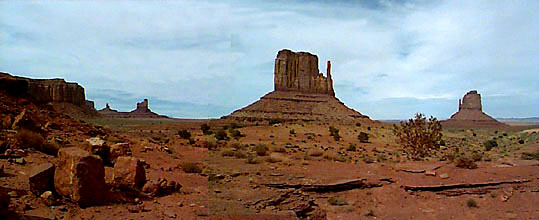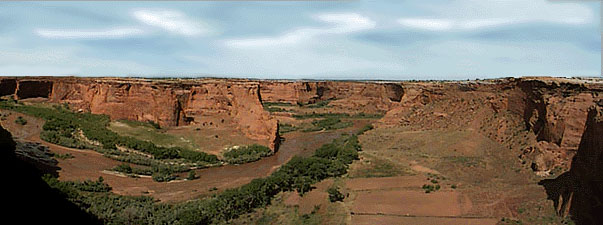



|
Much of the four corners area is quite high in altitude. Vegetation is sparse but very diverse and hardy. Plants have evolved to conserve water and to cope with the higher levels of ultraviolet light that penetrate the thin atmosphere - one mile above sea level. The humans that occupied this area were forced to rely upon each other and quickly learned the benefits of
agricultural planting and storing grain.

Monument Valley, Sixth Wonder of the Modern World, homeland to the Navajo, and a destination for tourists from around the globe. Poised on the Utah and Arizona border, Monument Valley has inspired writers and cinematographers and is a popular motif of the West.
Today, the Native Americans that dwell here, as well as their predecessors, place great emphasis on the cycle of the seasons and the importance and vitality of water. The religion and culture of these indigenous people is intimately linked with the earth and
nature and is characterized by beliefs in myriad spirits and signs. It is a religion of the earth for the people of the earth and it has endured for much longer than our history is able to record.
Around 900 A.D., the Anasazi, main cultural ancestors of the Pueblo communities, came into prominence in the Four Corners Region. Nomadic hunters and foragers, who may have ventured in from the Mojavi Desert, the Anasazi settled in this area, creating large communities in Kayenta and Canyon de Chelly, Arizona, as well as Mesa Verde in Colorado, and New Mexico's Chaco Canyon.
 A panoramic view of Canyon de Chelly (pronounced "shay").
The Anasazi settled in- raising corn, creating pottery and building large, functional communities. They lived partly underground at first, but then began to build above-ground storage for their harvests. These structures, created from a mud-covered latticework frame, proved to be so functional and comfortable that the Anasazi started living in them.
As their communities grew, the building skills of the people grew with them. The Anasazi builders achieved an incredible degree of architectural mastery. Within and alongside the cliffs of the canyons they created multi-apartment complexes, many multi-storied.
They Anasazi prospered here until just around 1150, it is believed, when severe drought may have driven them to migrate to other areas. Shortly after that time, the Navajo took up residence in this part of the land.
In our next exploration we'll take you Tsegi Canyon and Mystery Valley for a close-up look at some of these dwellings and the petroglyphs and pictographs left by their ancient inhabitants. Don't miss it!

|